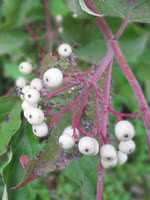Mon-Fri 9am - 5pm Mountain time
Western Snowberry vs Gray Dogwood
Symphoricarpos occidentalis
Cornus racemosa
NOT AVAILABLE THIS SEASON - MIGHT RETURN
CUSTOM GROW
Like the Common Snowberry, the Western Snowberry is a small shrub with pink flowers useful for feeding livestock and preventing erosion. Unlike the common species, however, the Western Snowberry is much more suited to wet conditions, capable of persevering through poor soil drainage and occasional flooding.
After the Snowberry's flowers have bloomed, it produces berries which often last on the plant through winter. These berries are toxic to humans, but livestock and local wildlife love them! Those hoping to attract wildlife to their property can plant Snowberry and expect to see animals foraging on it much later in the year than other plants.
Gray dogwood is a thicket-forming, deciduous shrub with greenish-white blossoms in open, terminal clusters. Young twigs are red and the fruit pedicels remain conspicuously red into late fall and early winter.
Fruit itself is a white, 1/4 in. drupe that usually does not remain on the shrub for long.
Great for naturalizing wild areas, this shrub attracts birds and other wildlife.
Western Snowberry Quick Facts
Gray Dogwood Quick Facts
Toxicity: berries are toxic to humans

